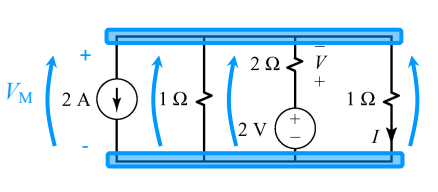Note 03
Millman’s theorem & basic equivalences
Millman’s topology
A circuit that consists of all parallel connection of only the following type:
- resistors
- ideal current sources
- series connections of and ideal voltage source and a resistor
- Note resistors in series to the current source do not affect the Millman Voltage so we should not include it’s conductance in our calculations

Millman’s theorem
\[V_m = \frac{[A] + [B]}{[C]}\]Where:
$[A]$ = $\sum \pm G_kE_k$ for the branches with the voltage sources and resistors in series (positive is the voltage is in the same direction as the $V_m$
$[B] = \sum \pm A_k$ for the branches with current sources (positive if the direction of the current is the same as the $V_m$
$[C] = \sum $ condunctace of all resistors
Millman derived his theorem using a KCL at one of the two common nodes shared by the branches in a circuit of his topology type.
Examples
Source transformation
Two elements are equivalen if they have the same characteristic equation.
Typically:
- A voltage source with a resistor in series converts to a current source with a resistor in parallel.
- And vice versa, a current source with a resistor in parallel converts to a voltage source with a resistor in series.